Abbreviation For Declination −30 Bayer/Flamsteed designation 27 | Genitive Fornacis Right ascension 3 Main stars 2 Stars with planets 6 | |
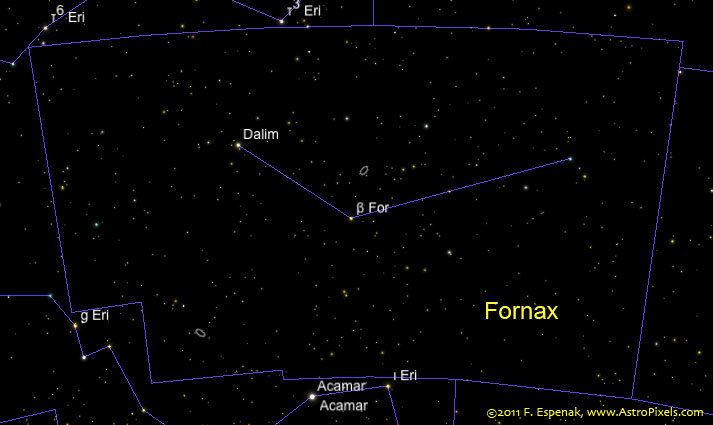 | ||
Pronunciation /ˈfɔːrnæks/, genitive /fɔːrˈneɪsᵻs/ Similar Sculptor, Grus, Caelum, Microscopium, Reticulum | ||
Hubble hd zoom into the fornax constellation
Fornax (/ˈfɔːrnæks/) is a constellation in the southern sky, partly ringed by the celestial river Eridanus. Its name is Latin for furnace. It was named by French astronomer Nicolas Louis de Lacaille in 1756. Fornax is one of the 88 modern constellations.
Contents
- Hubble hd zoom into the fornax constellation
- Fornax constellation
- History
- Characteristics
- Stars
- Deep sky objects
- Equivalents
- References
The three brightest stars—Alpha, Beta and Nu Fornacis—form a flattened triangle facing south. With an apparent magnitude of 3.91, Alpha Fornacis is the brightest star in Fornax. Six star systems have been found to have exoplanets.
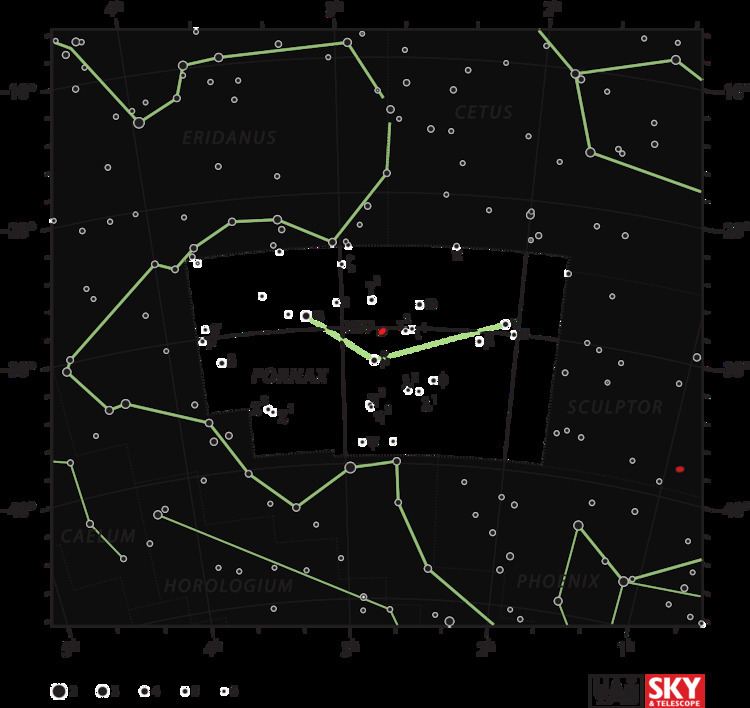
Fornax constellation
History
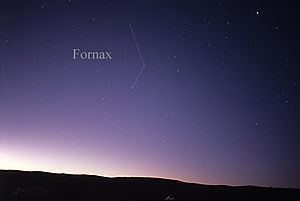
The French astronomer Nicolas Louis de Lacaille first described the constellation in French as le Fourneau Chymique (the Chemical Furnace) with an alembic and receiver in his early catalogue, before abbreviating it to le Fourneau on his planisphere in 1752, after he had observed and catalogued almost 10,000 southern stars during a two-year stay at the Cape of Good Hope. He devised fourteen new constellations in uncharted regions of the Southern Celestial Hemisphere not visible from Europe. All but one honoured instruments that symbolised the Age of Enlightenment. Lacaille Latinised the name to Fornax Chimiae on his 1763 chart.
Characteristics
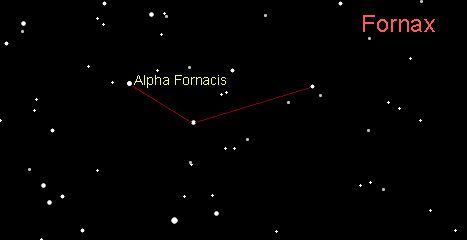
The constellation Eridanus borders Fornax to the east, north and south, while Cetus, Sculptor and Phoenix gird it to the north, west and south respectively. Covering 397.5 square degrees.and 0.964% of the night sky, it ranks 41st of the 88 constellations in size, The three-letter abbreviation for the constellation, as adopted by the International Astronomical Union in 1922, is 'For'. The official constellation boundaries, as set by Eugène Delporte in 1930, are defined by a polygon of 8 segments (illustrated in infobox). In the equatorial coordinate system, the right ascension coordinates of these borders lie between 01h 45m 24.18s and 03h 50m 21.34s, while the declination coordinates are between -23.76° and -39.58°. The whole constellation is visible to observers south of latitude 50°N.
Stars
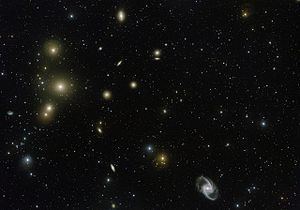
Lacaille gave Bayer designations to 27 stars now named Alpha to Omega Fornacis, labelling two stars 3.5 degrees apart as Gamma, three stars Eta, two stars Iota, two Lambda and three Chi. Phi Fornacis was added by Gould, and Theta and Omicron were dropped by Gould and Baily respectively. Upsilon, too, was later found to be two stars and designated as such. Overall, there are 59 stars within the constellation's borders brighter than or equal to apparent magnitude 6.5. However, there are no stars brighter than the fourth magnitude.
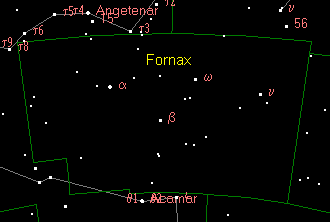
The three brightest stars form a flattish triangle, with Alpha and Nu Fornacis marking its eastern and western points and Beta Fornacis marking the shallow southern apex. Originally designated 12 Eridani by John Flamsteed, Alpha Fornacis was named by Lacaille as the brightest star in the new constellation. It is a binary star that can be resolved by small amateur telescopes. With an apparent magnitude of 3.91, the primary is a yellow-white subgiant 1.21 times as massive as the Sun that has begun to cool and expand after exhausting its core hydrogen, having swollen to 1.9 times the Sun's radius. Of magnitude 6.5, the secondary star is 0.78 times as massive as the Sun. It has been identified as a blue straggler, and has either accumulated material from, or merged with, a third star in the past. It is a strong source of X-rays. The pair is 46.4 ± 0.3 light-years distant from Earth.
Beta Fornacis is a yellow-hued giant star of spectral type G8IIIb of magnitude 4.5 that has cooled and swelled to 11 times the Sun's diameter, 169 ± 6 light-years from Earth. It is a red clump giant, which means it has undergone helium flash and is currently generating energy through the fusion of helium at its core.
Nu Fornacis is 370 ± 10 light-years distant from Earth. It is a blue giant star of spectral type B9.5IIIspSi that is 3.65 ± 0.18 times as massive and around 245 times as luminous as the Sun, with 3.2 ± 0.4 times its diameter. It varies in luminosity over a period of 1.89 days—the same as its rotational period. This is because of differences in abundances of metals in its atmosphere; it belongs to a class of star known as an Alpha2 Canum Venaticorum variable.
Shining with an apparent magnitude of 5.89, Epsilon Fornacis is a binary star system located 105 ± 1 light-years distant from Earth. Its component stars orbit each other every 37 years. The primary star is around 12 billion years old and has cooled and expanded to 2.53 times the diameter of the Sun, while having only 91% of its mass. Omega Fornacis is a binary star system composed of a blue main-sequence star of spectral type B9.5V and magnitude 4.96, and a white main sequence star of spectral type A7V and magnitude 7.88.
LP 944-20 is a brown dwarf of spectral type M9 that has around 7% the mass of the Sun. Approximately 21 light-years distant from Earth, it is a faint object with an apparent magnitude of 18.69. Observations published in 2007 showed that the atmosphere of LP 944-20 contains much lithium and that it has dusty clouds. Smaller and less luminous still is 2MASS 0243-2453, a T-type brown dwarf of spectral type T6. With a surface temperature of 1040–1100 K, it has 2.4–4.1% the mass of the Sun, a diameter 9.2 to 10.6% of that of the Sun, and an age of 0.4–1.7 billion years.
Six star systems in Fornax have been found to have planets:
Deep-sky objects
NGC 1049 is a globular cluster 500,000 light-years from Earth. It is in the Fornax Dwarf Galaxy. NGC 1360 is a planetary nebula in Fornax with a magnitude of approximately 9.0, 978 light-years from Earth. Its central star is of magnitude 11.4, an unusually bright specimen. It is five times the size of the famed Ring Nebula in Lyra at 6.5 arcminutes. Unlike the Ring Nebula, NGC 1360 is clearly elliptical.
The Fornax Dwarf galaxy is a dwarf galaxy that is part of the Local Group of galaxies. It is not visible in amateur telescopes, despite its relatively small distance of 500,000 light-years.
NGC 1097 is a barred spiral galaxy in Fornax, about 60 million light-years from Earth. At magnitude 9, it is visible in medium amateur telescopes. It is notable as a Seyfert galaxy with strong spectral emissions indicating ionized gases and a central supermassive black hole.
NGC 1365 is another barred spiral galaxy located at a distance of 60 million light-years from Earth. Like NGC 1097, it is also a Seyfert galaxy. Its bar is a center of star formation and shows extensions of the spiral arms' dust lanes. The bright nucleus indicates the presence of an active galactic nucleus - a galaxy with a supermassive black hole at the center, accreting matter from the bar. It is a 10th magnitude galaxy associated with the Fornax Cluster.
Fornax A is a radio galaxy with extensive radio lobes that corresponds to the optical galaxy NGC 1316, a 9th-magnitude galaxy. One of the closer active galaxies to Earth at a distance of 80 million light-years, Fornax A appears in the optical spectrum as a large elliptical galaxy with dust lanes near its core. These dust lanes have caused astronomers to discern that it recently merged with a small spiral galaxy. Because it has a high rate of type Ia supernovae, NGC 1316 has been used to determine the size of the universe. The jets producing the radio lobes are not particularly powerful, giving the lobes a more diffuse, knotted structure due to interactions with the intergalactic medium. Associated with this peculiar galaxy is an entire cluster of galaxies.
Fornax has been the target of investigations into the furthest reaches of the universe. The Hubble Ultra Deep Field is located within Fornax, and the Fornax Cluster, a small cluster of galaxies, lies primarily within Fornax. At a meeting of the Royal Astronomical Society in Britain, a team from University of Queensland described 40 unknown "dwarf" galaxies in this constellation; follow-up observations with the Hubble Space Telescope and the European Southern Observatory's Very Large Telescope revealed that ultra compact dwarfs are much smaller than previously known dwarf galaxies, about 120 light-years (37 pc) across.
UDFj-39546284 is a candidate protogalaxy located in Fornax, although recent analyses have suggested it is likely to be a lower redshift source.
Equivalents
In Chinese astronomy, the stars that correspond to Fornax are located within the White Tiger of the West (西方白虎, Xī Fāng Bái Hǔ).
